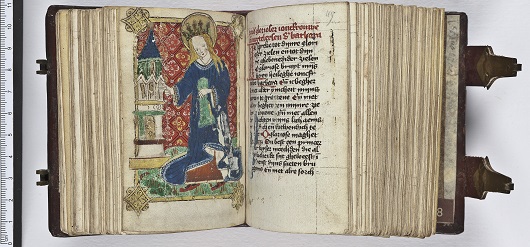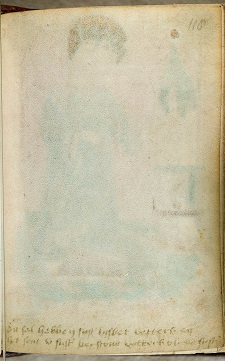Postcards on parchment reveal medieval use of “social media”

Medieval people used small works of art in the same way we use social media today, to reveal status, allegiances and values, a new book reveals.
Author Dr Kathryn Rudy, of the University of St Andrews, found hundreds of lost artworks between the pages of medieval prayer books.
The images had been wrongly classified as manuscript illuminations but Dr Rudy discovered they were in fact personal notes, mementoes, and small painted images similar to modern postcards, which were kept in the religious books for safe keeping.
For a decade, Dr Rudy carried out the research of medieval books in more than 30 libraries in seven countries – including England and Scotland – for her new book Postcards on Parchment: The Social Lives of Medieval Books, published by Yale University Press.
Many of these lost items had been classified as manuscript illumination, but Dr Rudy argues that these pictures should instead be called parchment paintings, similar to postcards. She discovered that medieval book owners collected and traded such images, so the books into which they were affixed today provide a record of social bonds, or a treasure chest of small gifts.
The medieval art expert identified more than 200 examples, reclassified them as ‘once-loose paintings’ and has now compiled them in a new book which contains many images that had never before been published.
 This project has received a grant to study and reproduce images from Glasgow from the Catherine Mackichan Trust (£300), and partial subventions for images from the Carnegie Trust of the Universities of Scotland (£2180) and the Historians of Netherlandish Art ($1000), and from the School of Art History, University of St Andrews.
This project has received a grant to study and reproduce images from Glasgow from the Catherine Mackichan Trust (£300), and partial subventions for images from the Carnegie Trust of the Universities of Scotland (£2180) and the Historians of Netherlandish Art ($1000), and from the School of Art History, University of St Andrews.
Dr Rudy, senior lecturer in the School of Art History, said: “In some ways, medieval people were similar to us in that they traded small images as a way to forge social bonds, just as we post images on social media sites today – to reveal our status, our allegiances and our values. Recipients of small gifts would form a favourable memory of the giver each time they gazed upon the picture.
“Whereas manuscript illuminations were designed to provide a visual narrative to a book’s text, parchment paintings offered a kind of autonomous currency for exchange between individuals – people who longed for saturated colour in a grey world of wood, stone and earth.
“These small, often colourful pictures offered a brilliant reprieve, and these intriguing and previously unfamiliar images were traded and cherished, shedding light into the everyday life and relationships of those in medieval times.”
Notes to news editors
Image caption: Fifteenth-century postcard on parchment with an image of St Barbara, which has been inserted into a prayerbook (top); the back of the image has an inscription, indicating that it was given by Kerstine Vetters to her sister Lijsbet Vetters (bottom).
To interview Dr Rudy please contact the press office.
Issued by the University of St Andrews Communications Office, contactable on 01334 467310 or 462530 or via [email protected].
Category Research